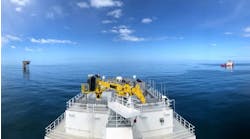Offshore staff
OSLO, Norway – Applied Petroleum Technology (APT) and Fluid Inclusion Consulting (FIC), based in Chester, UK, have agreed to jointly provide post-well analyses for E&P companies.
The service will combine three technologies: APT’s wellsite gas processing and interpretation software package Girasol (Gas interpretation reservoir analysis software); FIC’s exclusive access to Fluid Inclusion Technologies’ datasets; and Rockwash Geodata’s patented sample washing and digitization process.
Julian Moore, head of APT’s UK operation, said: “To date there has been very little innovation in how the oil industry treats the data captured from the wells drilled with respect to rocks collected and the gases measured.
“Typically, this data ends up in a pdf-file on a company server and is little used once the well is drilled; our technologies will create digital datasets far more amenable to analysis, providing more value to the data acquired and deeper technical insights.”
The new service, he added, will offer low-cost analytical results to assess distribution of potential reservoirs, pay zones, shows and residual petroleum anomalies.
APT’s Girasol software features a normalization function that attempts to remove the drilling signal and a compositional correction for applications involving use of oil-based muds are used, providing a normalized, corrected gas dataset.
FIT’s datasets include data captured through analysis of trapped fluids in rock material, with a focus on determining the history of a given petroleum system. And via the association with Rockwash Geodata, FIC also has access to PhotoSTRAT and XRF datasets, said to provide geoscientists with detailed insight into the depositional setting of the entire stratigraphic column.
Jack Cawthorne, managing director of FIC, said: “We will be able to offer new insights into the petroleum system by evaluating subsurface fluids that have been recorded through multiple methods, whilst also adding lithological context. Ultimately, we feel that this product will help geoscientists to better understand the complexities of the subsurface.”
08/05/2020



